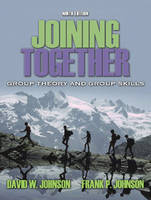
Joining Together
Pearson (Verlag)
978-0-205-45373-3 (ISBN)
- Titel erscheint in neuer Auflage
- Artikel merken
Preface.
1. Group Dynamics.
Basic Concepts to Be Covered in This Chapter
Group Dynamics and Me
What Is a Group?
The Importance of Groups
Group Structure
Creating Productive Groups
How to Create an Effective Group
The Development of Groups Over Time
The Field of Group Dynamics
The Nature of This Book and How to Use It
Summary
2. Experiential Learning.
Basic Concepts to Be Covered in This Chapter
Procedural Learning
Action Theories
Gaining Expertise Through Experiential Learning
Experiential Learning and Motivation
Learning Group Skills
Role Playing
Learning How to Be a Participant-Observer
Conducting Skill-Training Exercises
Ethics of Experiential Learning
Summary
3. Group Goals, Social Interdependence, and Trust.
Basic Concepts to Be Covered in This Chapter
Introduction
What Is a Goal?
START Goals
Clarity of Goals
Operational Goals
Group Goals and Level of Aspiration
Dealing with Hidden Agendas
Helping Groups Set Effective Goals
Group Goals and Social Interdependence Among Members
Outcomes of Social Interdependence
Effort to Achieve and Produce
Reciprocal Relationships Among the Three Outcomes
Mediating Variables: The Basic Elements of Cooperation
The Stability of Cooperation
Goal Structures and the Allocation of Benefits
Among Group Members
Mixed-Motive Situations
Developing and Maintaining Trust
Summary
4. Communication Within Groups.
Basic Concepts to Be Covered in This Chapter
Introduction and Definitions
Group Communication
Sending and Receiving Messages
Communication in a Problem-Solving Group
Interaction Analysis
Communication Networks
Communication Patterns in an Authority Hierarchy
Influences on Effectiveness of Group Communication
Effects of Cooperation and Competition on Communication
Physical Influences on Communication
Seating Arrangements
Humor
Summary
5. Leadership.
Basic Concepts to Be Covered in This Chapter
What Is Leadership?
Trait Theories of Leadership
Leadership Styles
Influence Theory of Leadership
Role Position/Group Structure Approach to Leadership
Situational Theories of Leadership
Organizational Leadership
What If You Do Not Want to Be a Leader?
Summary
6. Using Power.
Basic Concepts to Be Covered in This Chapter.
Introduction.
What Is Power?
The Dynamic Interdependence
View of Power
Mobilizing Power to Achieve Goals
The Trait-Factor Approach to Power
The Bases of Power
Conflict Model of Social Influence
Power and Problem Solving
Unequal Power
Group Norms: Indirect Power
The Group Mind
Individual Versus Relationship Perspectives
Summary
7. Decision Making.
Basic Concepts to Be Covered in This Chapter
Making Effective Decisions
Individual Versus Group Decision Making
Methods of Decision Making
Factors Enhancing Group Decision Making
Factors Hindering Group Decision Making
Considered and Thoughtful Decision Making
Problems with Theorizing on Decision Making
Summary
8. Controversy and Creativity
Basic Concepts to Be Covered in This Chapter
Controversy and Decision Making
The Avoidance of Controversy
Outcomes of Controversy
Creativity
Process of Controversy
Conditions Determining the Constructiveness of Controversy
Minority Influence, Controversy, and Decision Making
Structuring Constructive Controversies
Being a Citizen in a Democracy
Creative Problem Solving
Developing and Fostering Creativity
Open Versus Closed Belief Systems
Brainstorming
Summary
9. Managing Conflict of Interests.
Basic Concepts to Be Covered in This Chapter
Conflict Positive Groups
Nature of Conflicts of Interests
Conflicts Can Be Destructive or Constructive
Conflict and Aggression
Conflict Strategies: What Are You Like?
Controlling the Occurrence of Conflicts
The Nature of Negotiations
Two Types of Negotiating
The Integrative Negotiating Procedure
Defining the Conflict as a Mutual Problem
Try, Try Again
Negotiating in Good Faith
Refusal Skills: This Issue Is Non-Negotiable
Intergroup Conflict
Third-Party Mediation
Summary
10 Valuing Diversity.
Basic Concepts to Be Covered in This Chapter
Introduction
Sources of Diversity
Importance of Managing Diversity
The Value of Diversity
Barriers to Interacting with Diverse Peers
Making Member Diversity a Strength
Summary
11. Cooperative Learning in the Classroom.
Basic Concepts to Be Covered in This Chapter
Nature of Cooperative Learning
Formal Cooperative Learning: Being A “Guide on the Side”
Preinstructional Decisions
Explaining the Task and Cooperative Structure
Monitoring and Intervening
Evaluating Learning and Processing Interaction
Informal Cooperative Learning Groups
Using Informal Cooperative Learning
Base Groups
Integrated Use of All Three Goal Structures
The Cooperative School
Summary
12. Leading Growth and Counseling Groups.
Basic Concepts to Be Covered in This Chapter
Introduction
Types of Therapeutic Groups
The Unique Power of Group Experiences
Importance of Disclosing Emotions
Leading a Growth Group
Conceptual Frameworks, Feelings, and Intuition
Becoming a Facilitator
Growth Groups and Participant Anxiety
Costs of Growth and Therapy Groups
Comparative Effectiveness
Summary
13. Team Development, Team Training.
Basic Concepts to Be Covered in This Chapter
Introduction
What Is a Team?
Types of Teams
Organizational Context
Building Productive Teams
Research on Team Effectiveness
Forming, Structuring, and Nurturing Teams
Use of Teams in Training Programs
Team Building
Assessing Quality of Work
Total Quality Management
Dealing with Problem Behaviors in Teams
Summary
14. Epilogue.
Guidelines for Creating Effective Groups
Learning Group Skills
Summary
Appendix: Answers.
Glossary.
References.
Index.
| Erscheint lt. Verlag | 5.9.2005 |
|---|---|
| Sprache | englisch |
| Maße | 179 x 235 mm |
| Gewicht | 938 g |
| Themenwelt | Geisteswissenschaften ► Psychologie ► Sozialpsychologie |
| Sozialwissenschaften ► Pädagogik ► Sozialpädagogik | |
| Sozialwissenschaften ► Soziologie | |
| ISBN-10 | 0-205-45373-2 / 0205453732 |
| ISBN-13 | 978-0-205-45373-3 / 9780205453733 |
| Zustand | Neuware |
| Haben Sie eine Frage zum Produkt? |
aus dem Bereich



